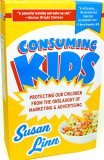Summary | Excerpt | Reading Guide | Reviews | Beyond the Book | Readalikes | Genres & Themes | Author Bio

Critics' Opinion:
Readers' Opinion:
First Published:
May 2004, 256 pages
Paperback:
Aug 2005, 304 pages
 Book Reviewed by:
Book Reviewed by:
BookBrowse Review Team
Buy This Book
Because children are unable to employ such judgment, they are more vulnerable to marketing.
Preschool children, for instance, have trouble differentiating between commercials and regular programming on television. Slightly older children can make the distinction, but they are concrete thinkers, tending to believe what they see in a fifteen-second commercial for cookies or a toy. Until the age of about eight, children can't really understand the concept of persuasive intent—that every aspect of an ad is selected to make a product appealing and to convince people to buy it. Older kids and teens might be more cynical about advertising, but their skepticism doesn't seem to affect their tendency to want or buy the products they see so glowingly portrayed all around them.
I recently sat with a group of elementary school kids who all told me that commercials do not tell the truth, yet when asked, they all had strong opinions about which was the "best" brand of sneaker. Their opinions were based not on their own experience but on what they'd seen on TV and in magazine ads. Advertising appeals to emotions, not to intellect, and it affects children even more profoundly than it does adults.
Unfortunately, marketing is so ingrained in the fabric of American life that it's hard to generate much concern about its effects on kids. Most of us have fond memories of advertising: those Burma Shave signs whizzing by on the highway, Arthur Godfrey winking at us in black-and-white as he sipped his cup of Lipton Tea, Clara Peller growling "Where's the beef?" for Wendy's in the 1980s, and little Mikey gobbling up Life cereal to the amazement of his older siblings. We all have favorite commercials, and it's significant that many of these favorites are ads we remember from childhood.
That I'm both a parent and a psychologist contributes to my sense of urgency and personal outrage about the extent to which corporate interests subsume modern childhood. As the mother of a teenager whose growing up has coincided with an increasing intensity and sophistication of marketing efforts targeted at children, I struggle on a personal level to cope with its harmful effects. As a therapist working with young children, I see its impact on other people's children as well.
My concerns about kids and commercialism, the foundations of which date from my own childhood, have always influenced my professional choices. From the mid-1930s on, my parents were actively involved in struggles for social justice. My mother was a pioneer in the early childhood education movement. As an adult, carving out my own work with children, I took from her and her colleagues a sense of wonder about childhood—not a naive, romantic perception of blissful early years, but rather a recognition of the amazing possibilities inherent in each child. Creativity, originality, and integrity deserve to be nurtured, and all adults have an ongoing obligation to keep children's best interests at heart.
At the age of six I developed an admittedly eccentric, but enduring, fascination with ventriloquism that blossomed into a career. By my early twenties, I was earning my living with my puppets—through live and televised performances, by creating video programs about difficult issues for kids, and eventually as a puppet therapist at Boston Children's Hospital. Along the way, I earned a doctorate in psychology. I was fortunate to be able to work with the late Fred Rogers of Mister Rogers' Neighborhood, appearing on his program early in my career. With Family Communications, Inc., the company he founded, I have been writing and performing in video programs ranging in topics from helping children with cancer go back to school, to racism, prejudice, and diversity.
My stepson, Josh, was born in 1971. My daughter, Sasha, was born in 1987. Josh's daughter, Marley, was born in 2002. I can't help but contrast the commercial pressures affecting their experience of growing up. When Josh was a child, public television really was commercial-free. It is no longer. Nor did most of his friends have TVs in their rooms. While he did have to cope with sugar cereal ads on Saturday morning television, he did not have to deal with a barrage of soda and junk food marketing in school, unlike Sasha. And, when riding in a grocery cart neither Josh nor Sasha (unlike Marley) had to face aisle after aisle jammed with alluring, brightly colored packages containing edible, high-calorie renditions of his favorite cartoon characters, or candy in the shape of superheroes. The first video games came into being when Josh was a teenager, but the technological capacity for depicting media violence in graphic, gory detail did not develop until he was almost an adult. He listened to the radio, but while Sasha's music is interrupted with incessant ads for violent and sexually explicit television programs and movies, his was not.
From Consuming Kids by Susan Linn, pages 1-10. Copyright Susan Linn 2004. All rights reserved. No part of this book maybe reproduced without written permission from the publisher, The New Press.





The House on Biscayne Bay
by Chanel Cleeton
As death stalks a gothic mansion in Miami, the lives of two women intertwine as the past and present collide.

The Flower Sisters
by Michelle Collins Anderson
From the new Fannie Flagg of the Ozarks, a richly-woven story of family, forgiveness, and reinvention.

The Funeral Cryer by Wenyan Lu
Debut novelist Wenyan Lu brings us this witty yet profound story about one woman's midlife reawakening in contemporary rural China.
Your guide toexceptional books
BookBrowse seeks out and recommends the best in contemporary fiction and nonfiction—books that not only engage and entertain but also deepen our understanding of ourselves and the world around us.